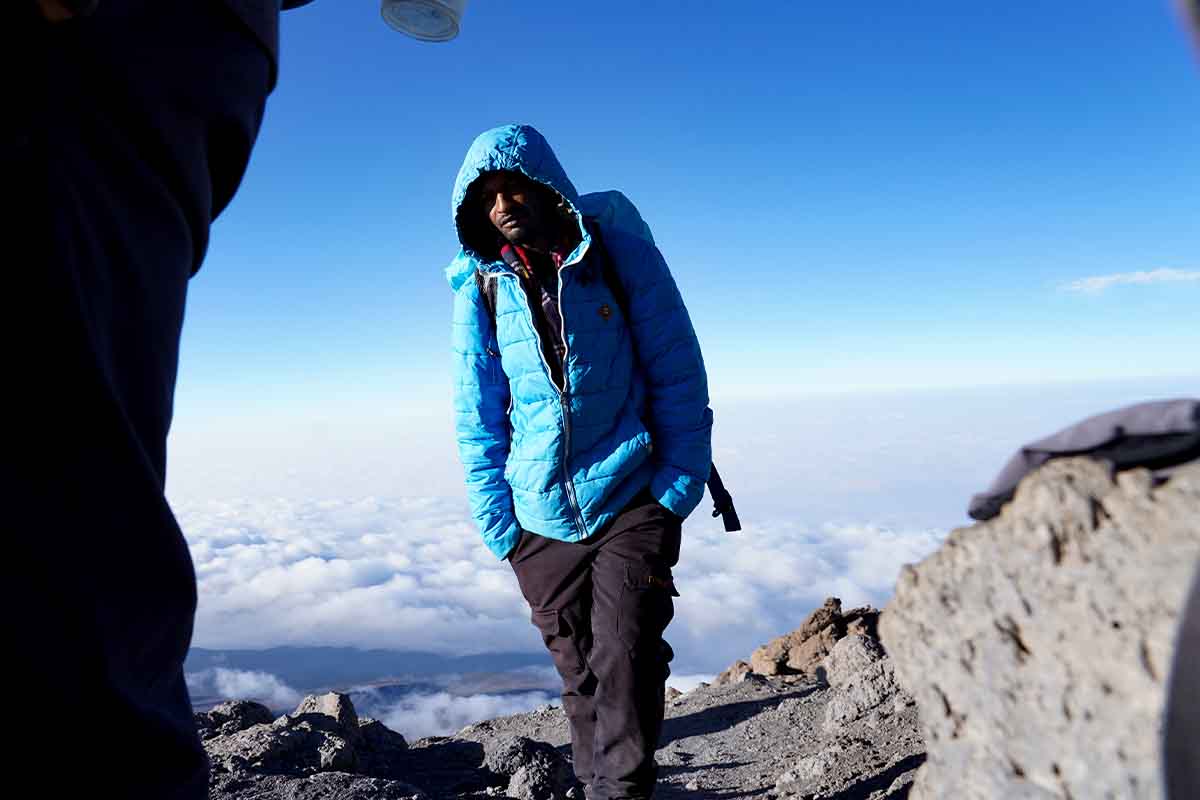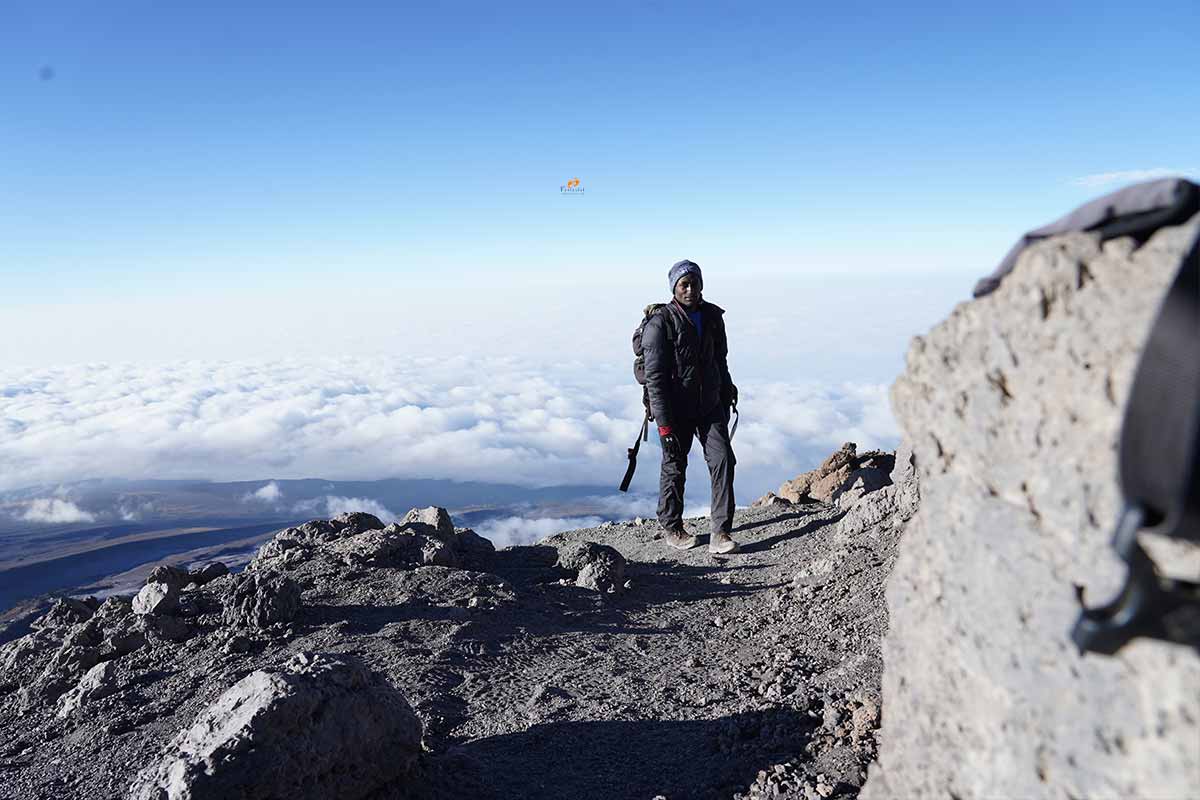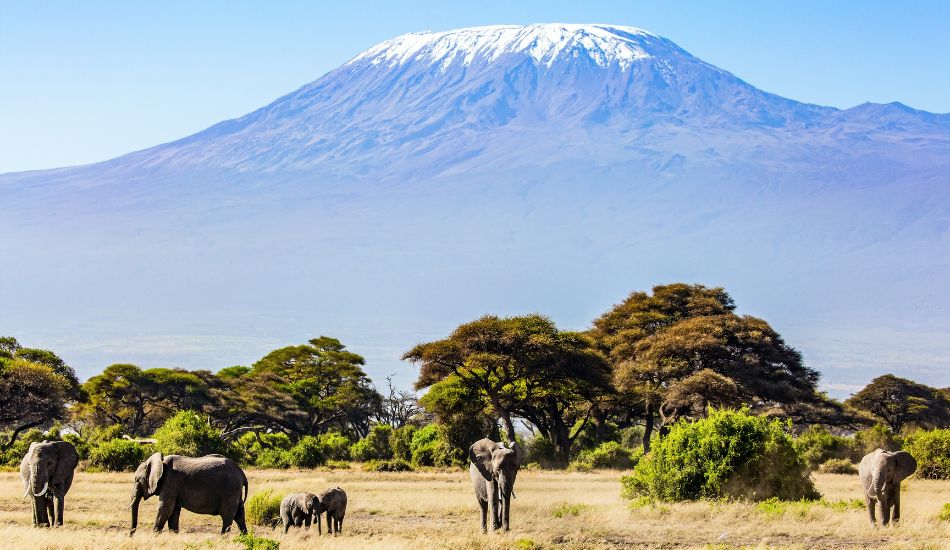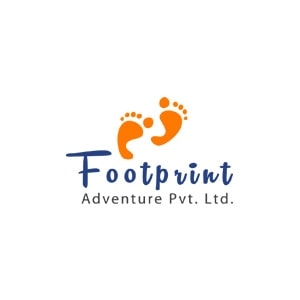Why the Right Gear Matters on Kilimanjaro
Kilimanjaro’s diverse climate zones can catch even experienced trekkers off guard. With the help of well-prepared porters and good gear, the lowland is hot and sweaty jungles, and the top day is cold enough with a temperature range around -20C and 4 F. A carefully curated packing list ensures that you:
- Stay warm and dry in harsh conditions.
- Carry only what’s necessary to avoid unnecessary fatigue.
- Enjoy every step without stressing about your gear.
- Prevent altitude sickness with proper hydration and preparation tools.
Packing isn’t just about survival—it’s about enjoying the climb. Now, let’s get to the essentials!
Conquering Mount Kilimanjaro is an adventure you’ll never forget—but preparation is key. Book your Kilimanjaro climb with Footprint Adventure today, and get ready for the adventure of a lifetime!
Recommendation Read: Training Plan for Kilimanjaro Climb

Kilimanjaro Packing List: Your Gear Essentials
Below, we break down everything you need for your expedition—categorized by clothing, footwear, bags, sleep gear, hydration, and safety essentials.
Clothing: Layering for All Conditions
You’ll move through extreme weather, so layering is crucial. You’ll need a base layer to stay dry, mid-layers for warmth, and outer layers to block wind and rain. Let’s break it down:
- Base Layers (Moisture-Wicking)
- 2-3 thermal shirts and leggings (synthetic or merino wool).
- Short-sleeve moisture-wicking T-shirts for lower altitudes.
- Mid-Layers (Warmth)
- Fleece jacket or pullover.
- Lightweight down jacket (packable but warm).
- Outer Layers (Protection from Elements)
- GORE-TEX or waterproof jacket.
- Waterproof hiking pants for rainy days.
- Other Clothing Essentials
- Convertible hiking pants (that zip into shorts).
- Warm hat or beanie and neck gaiter for summit day.
- Sun hat or cap for the lower slopes.

Pro Advice: Avoid cotton. It traps moisture and will leave you cold. Stick to synthetic fabrics or wool for better temperature control.
Learn About Kilimanjaro Climbing Difficulty
Footwear: Protect Your Feet for Long Days of Hiking
Trekking up Kilimanjaro means long hours on rocky paths, through mud, and possibly snow. Make sure your boots are comfortable and broken-in before the trip!
- Hiking Boots
- Waterproof with ankle support.
- Recommended brands: Salomon, Merrell, or Lowa.
- Camp Shoes
- Lightweight sandals or sneakers for relaxing at camp.
- Socks
- 3-4 pairs of merino wool trekking socks.
- 2 pairs of thick thermal socks for summit night.
Pro Advice: Bring moleskin tape or blister pads—your feet will thank you.

Bags: Keep Your Gear Organized and Protected
Porters will carry most of your belongings, but you’ll still need a daypack for daily essentials.
- Daypack (20-30L)
- For carrying water, snacks, extra layers, and your camera.
- Look for padded shoulder straps and a hip belt for extra comfort.
- Duffel Bag (70-90L)
- This will hold your clothing and gear; porters will carry it.
- Make sure it’s waterproof, or use dry bags inside to keep things dry.
- Packing Cubes and Ziplock Bags
- Keep items organized and protect electronics from moisture.
Sleeping Gear: Stay Warm During Cold Nights
It can get freezing cold at higher altitudes, so having the right sleep gear is essential. A comfortable night’s sleep makes a big difference during multi-day trekking.
- Sleeping Bag
- Rated for at least -10°C (14°F). A down sleeping bag offers an excellent warmth-to-weight ratio.
- Sleeping Pad or Inflatable Mat
- Adds insulation and comfort when sleeping on the ground.
- Sleeping Bag Liner
- Adds warmth and helps keep your sleeping bag clean.
Pro Advice: Bring earplugs—some trekkers can be noisy at night!
Hydration and Snacks: Stay Fueled and Energized
Hydration is key to preventing altitude sickness, and you’ll need to drink water constantly throughout the climb.
- Water Bottles and Hydration Bladder
- Carry at least 3 liters of water daily.
- Use insulated bottles to prevent water from freezing on summit day.
- Water Purification Tablets
- Even though water is provided, it’s safer to treat it.
- High-Energy Snacks
- Pack energy bars, nuts, trail mix, or chocolate for quick energy boosts.
- Electrolyte tablets to replenish salts and prevent cramps.
Accessories and Safety Gear: Don’t Leave These Behind
These smaller items will make your trek safer and more enjoyable.
- Trekking Poles
- Helps reduce knee strain during descents.
- Headlamp and Extra Batteries
- Crucial for early morning summit attempts in the dark.
- Sunglasses
- Protect your eyes from UV rays and snow glare at high altitudes.
- Sunscreen (SPF 50+) and Lip Balm
- The sun at high altitudes can be intense—don’t skip sun protection.
- First Aid Kit
- Include blister treatment, altitude sickness medication (like Diamox), and painkillers.
- Portable Power Bank
- Keep your phone and camera charged to capture those epic moments.
Important Documents and Cash
Make sure you bring all the required paperwork and enough cash for tipping guides and porters.
- Passport and Visa
- Check that your passport is valid for at least six months.
- Travel Insurance
- Make sure your policy covers high-altitude trekking and emergency evacuation.
- Cash (USD)
- Bring small bills for tips—expect to tip around $200–300 USD for the team.

Additional Packing Tips for Kilimanjaro
- Pack Light but Smart: Limit your duffel to 15 kg (33 lbs)—that’s the weight limit for porters.
- Test Your Gear Beforehand: Wear your hiking boots on shorter hikes before the trip to break them in.
- Monitor the Weather Forecast: Check the forecast before departure to adjust your gear accordingly.
Read Our Blog:A Comprehensive Guidebook for Kilimanjaro Climbing
Final Thoughts
Packing for Mount Kilimanjaro isn’t just about survival—it’s about making your trek as enjoyable as possible. With this Kilimanjaro packing list, you’ll have everything you need to tackle every terrain the mountain throws your way. From humid jungles to the icy summit, you’ll be ready for the adventure of a lifetime.
Need help with planning your Kilimanjaro trek? Partner with Footprint Adventure for expert guidance, top-notch service, and unforgettable experiences. Your dream summit awaits—let’s make it happen!
FAQs
Can I rent gear in Tanzania?
Yes, most trekking companies offer gear rentals, including sleeping bags and trekking poles. However, bringing your own ensures better comfort.
How cold does it get on Kilimanjaro?
Temperatures at the summit can drop to -20°C (-4°F) or lower, especially at night.
What Should I Pack for Kilimanjaro?
Packing smart is the name of the game! The goal is to carry only what’s necessary—you’ll want to stay warm, dry, and comfortable without overloading yourself. Your must-have items include layered clothing (base, mid, and outer layers) for the ever-changing climate, broken-in hiking boots, a reliable daypack, and waterproof duffel bags. Don’t forget small but crucial items like trekking poles, sunscreen, a first-aid kit, and hydration gear. If you’re missing any essential equipment, many companies in Tanzania offer rentals for things like sleeping bags and poles.
How Cold Does It Get on Kilimanjaro?
Brace yourself—it gets really cold, especially near the summit! During your final ascent to Uhuru Peak, temperatures can drop as low as -20°C (-4°F). The nights at higher camps can also be bone-chilling. To handle the cold, pack thermal base layers, an insulated jacket, and waterproof outer layers. Having thermal gloves and socks for summit night is a must. Don't underestimate how quickly the weather can change on the mountain! Staying warm is key to enjoying your experience.
When’s the Best Time to Climb Kilimanjaro?
To enjoy a smoother trek, plan your adventure during one of Kilimanjaro’s two dry seasons—from January to March or June to October. These months provide clearer skies and more stable conditions, making the climb safer and more enjoyable. But keep in mind that weather at high altitudes can still be unpredictable, so always pack for rain and cold, even during the dry season.
How Can I Prevent Altitude Sickness in Kilimanjaro Climbing?
Altitude sickness is one of the biggest challenges when climbing Kilimanjaro. The key is to pace yourself—slow and steady wins the summit! Make sure to hydrate constantly and eat well. Some trekkers take Diamox to help with acclimatization, but always consult your doctor before using medication. Your guides will also monitor you for signs of altitude sickness, so if you feel unwell—like experiencing headaches or dizziness—speak up immediately. It’s all about listening to your body and not rushing to the top.
Can I Take a Shower on Kilimanjaro?
Nope, no showers on Kilimanjaro! Since water resources are limited, your camp will only provide warm bowls of water for washing your face and hands. A great alternative is to pack some wet wipes—they’ll be your best friend for freshening up along the way. Many trekking companies offer private toilet tents at campsites, but public facilities are available as well, though they tend to be quite basic. It’s all part of the adventure!
What Permits and Documents Do I Need?
To climb Kilimanjaro, you’ll need a Kilimanjaro National Park permit and a Tanzania visa. Your tour operator usually takes care of the park permits, so you just need to ensure your passport is valid for at least six months and apply for the visa in advance. No need to stress—if you book with a reliable trekking company, they’ll guide you through the paperwork process.
How Much Should I Tip My Guides and Porters?
Tipping is a huge part of the trekking culture on Kilimanjaro. Your guides and porters work incredibly hard to make your trek comfortable, so it’s customary to show your appreciation with tips. Expect to budget $200-$300 USD in total, which will be shared among your support crew (guides, porters, and cooks). Most operators provide detailed guidelines on tipping, and the amount varies depending on your group size and trek length.
What Physical Preparation is Needed?
You don’t need to be an athlete, but training ahead of time will make your climb more enjoyable. A solid fitness routine, focusing on hiking, cardio, and strength training, will help you prepare. Start your training 2-3 months before your climb, and don’t forget to practice hiking with a backpack. This will get you used to carrying the weight you’ll need to manage on Kilimanjaro.







